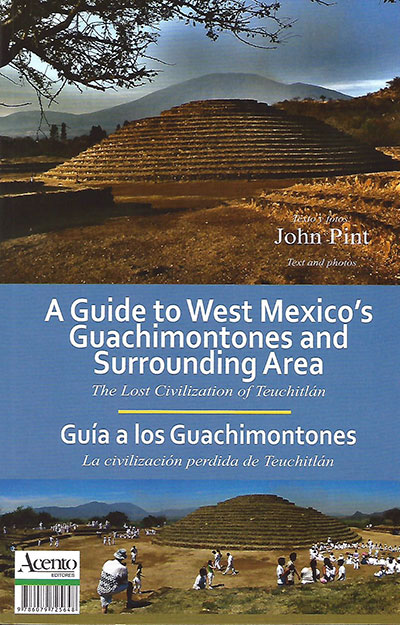EN ESPAÑOL
 This
new book, published in August of 2016, tells the story of the
wholly forgotten nation which--2000 years ago-- ruled a territory in
West Mexico the size of Guatemala. Unlike the Aztecs and Mayas, their
name was never known, but today they are called the people of the
Teuchitlán Tradition, after the site where many of their trademark
"circular pyramids" were excavated and studied during the last twenty
years. This
new book, published in August of 2016, tells the story of the
wholly forgotten nation which--2000 years ago-- ruled a territory in
West Mexico the size of Guatemala. Unlike the Aztecs and Mayas, their
name was never known, but today they are called the people of the
Teuchitlán Tradition, after the site where many of their trademark
"circular pyramids" were excavated and studied during the last twenty
years.
A Guide to West Mexico's
Guachimontones and Surrounding Area, The Lost Civilization of Teuchitlán
by John Pint, was published by Acento Editores, Guadalajara, Mexico.
This slim volume has 68 pages, 87 color photos and six maps and
sketches. The text is in English and Spanish, side by side.
The book
costs 130 pesos (US$6.63) plus postage and handling and can be
purchased from ranchopint@hotmail.com.
It is for sale
at the
Guachimontones Interpretive Center atTeuchitlán, at Gonvil Librerías in
Guadalajara and at La Perla Records & Books, Pedro Moreno 1530, Tel
(33) 1525 3015, Guadalajara.
EXCERPT
FROM A GUIDE
TO WEST MEXICO'S GUACHIMONTONES BY JOHN PINT:
Three-dimensional
Clay Models, 2000 Years Old
I
had no clue what the Guachimontones represented until one day in 1997,
when I heard rumors about an American archaeologist living in the town
of Etzatlán, 26 kilometers northwest of Teuchitlán. Tracking down a
foreigner in a small Mexican town is easy and this is how I first met
Phil Weigand. One of his many endearing characteristics was his total
lack of pretentiousness and his willingness to share his discoveries—at
length, I might add—with anyone who would listen, and I do mean anyone,
even the humblest rancher or laborer.
“Look at these clay models
of people gathered around the Guachimontones,” he said. “I've just had
them made. Each one is a faithful copy of a 2000-year-old original
found right here in this part of Jalisco. Aren't they amazing?”
“Amazing”
doesn't do justice to those clay models. Unlike the silent ruins in the
hills above Teuchitlán, these maquetas de barro are full of life. We see
dozens of people socializing, dancing, making music, playing ball or
watching the ball game, pushing against the tall pole which topped
every pyramid in what looks like a playful attempt to knock a “bird
man” off his perch. Even their dogs are included in the picture. Unlike
the stylized drawings found in codices, these clay models show ordinary
people having a good time. They are like family snapshots in three
dimensions. Approximately 25 clay sculptures related to the Teuchitlán
pyramids have been found, each of them different. Most of the originals
are now in the USA, many in museums...
CONTENTS
OF A GUIDE TO
WEST MEXICO'S GUACHIMONTONES BY JOHN PINT:
1. A Unique Civilization in Western Mexico
2. Phil and Acelia Weigand
3. Three-dimensional Clay Models, 2000 Years Old
4. The Ball Game
5. Daily Life
6. Obsidian
7. Shaft Tombs
8. Teuchitlán Twilight
9. The Guachimontones: A Quick Tour
10. The Guachimontones Interpretive Center “Phil Weigand”
11. Teuchitlan the Town: What to See and Where to Eat and
Sleep
12. Balneario El Rincón Water Park
13. The Teuchitlan Walking Trail and La Vega Restaurants
14. El Pedernal Obsidian Flow
15. Hacienda El Carmen Hotel-Restaurant-Spa
16. Hacienda Labor De Rivera Hotel-Boutique and Restaurant
17. The Tecpan of Oconahua: Mexico’s Largest Indigenous Palace
18. The Tala Museum
19. Other Attractions in Western Mexico
20. Bibliography

|

